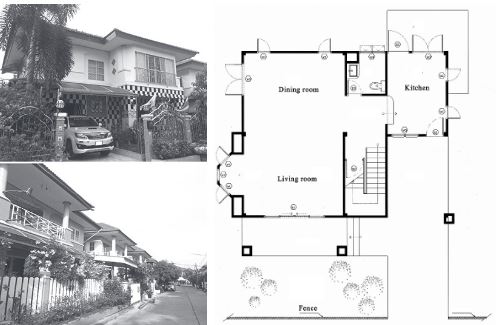Study of Thermal Comfort and the Adaptive Behaviors of the Elderly in Naturally Ventilated Houses
Keywords:
Adaptive behavior, Environmental controls, Comfort temperature, Hot and humid climateAbstract
The elderly’s adaptive behaviors to achieve thermal comfort is expected to play important roles in the housing designs under hot and humid climate. This research aims to investigate the adaptive behaviors of the elderly and their thermal comfort in naturally ventilated residential houses in Pathum Thani, Thailand. The 90 data sets are collected through questionnaires in 25 houses during the summer. The subjects include people with early old age (60-74 years old) who live with their families. The regression analysis on the survey data finds the subjects’ comfort temperature of 29.0 °C. There are 86% of the residents accept thermal environment of their own houses. The elder preferred a circulating fan to the air conditioner besides planting trees to provide shade. One or two circulating fans are always operated because of limitation of air ventilation from windows and doors. The subjects are active through behavioral adjustments to achieve thermal comfort during the warm day. Subjects choose drinking of cold water and taking shower several times instead of turning on air conditioner.
Downloads
References
ASHRAE. (2004). ASHRAE Standard 55/2004: Thermal Environmental Conditions for Human Occupancy. Atlanta: ASHRAE.
Busch, J. (1992). A tale of two populations: thermal comfort in air-conditioned and naturally ventilated office in Thailand. Energy and Buildings, 18, 235-249.
Dear, R. d., Brager, G., & Cooper, D. (1997). Developing an Adaptive Model of Thermal Comfort and Preference: FINAL REPORT ASHRAE RP- 884. American Society of Heating, Refrigerating and Air Conditioning Engineers, Inc.
Dear, R. d., Leow, K., & Foo, S. (1991). Thermal comfort in the humid tropics: field experiments in air conditioned and naturally ventilated buildings in Singapore. International Journal of Biometeorology, 259-265.
DEDE. (2014). Energy in Thailand: Fact & Figures Q1/2014. Bangkok: Alternative Energy and Efficiency Information Center.
EGAT. (2003). Thailand unite people against power crisis. Electricity Generating Authority of Thailand.
Feriadi, H., & Wong, N. H. (2004). Thermal Comfort for Naturally Ventilated Houses in Indonesia. Energy and Buildings, 36, 614-626.
Feriadi, H., & Wong, N. S. (2003). Adaptive behavior and thermal comfort in Singapore’s naturally ventilated housing. Building Research and Information, 31(1), 13-23.
Indragani, M. (2010). Behavioral adaptation and the Use of Environmental Controls in Summer for Thermal Comfort in Apartment in India. Energy and Buildings, 42, 1019-1025.
Indragani, M. (2010). Thermal comfort in naturally ventilated apartments in summer: Findings from a field in Hyderbad, India. Applied Energy, 87, 866-883.
Jareemit, D. , & Limmeechokchai, B. , ( 2019, January) . Impact of homeowner’s behaviours on residential energy consumption in Bangkok, Thailand. Journal of Building Engineering, 21, 328-335.
Karyono, T. (2000). Report on thermal comfort and building energy studies in Jarkata. Building and Environment, 35, 77-90.
Khedari, J. Y. (2000). Thailand ventilation comfort chart. Energy and Buildings, 32, 245-249.
McCartney, K. N. (2002). Developing an Adaptive Control Algorithm for Europe: Results of the SCATs project.Energy and Buildings, 34(6), 623-635.
Olgyay, V. (1963). Design with Climate. Princeton University Press, New Jersey.
Tangsiraksa, P. (2006). Thermal comfort in Bangkok residential Buildings, Thailand. PLEA2006-The 23rd Conference on Passive and Low Energy Architecture, (p. 6 pages). Geneva, Swizerland.

Downloads
Published
How to Cite
Issue
Section
License
Copyright (c) 2020 International Journal of Building, Urban, Interior and Landscape Technology (BUILT)

This work is licensed under a Creative Commons Attribution-NonCommercial-NoDerivatives 4.0 International License.











